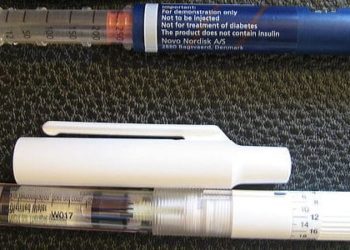Better glucose control with closed-loop system in children with type 1 diabetes
1. The closed-loop system maintained glucose levels within the target range for a significantly greater percentage of time for children with type 1 diabetes.
2. More adverse events were reported with use of the closed-loop system.
Evidence Rating Level: 1 (Excellent)
Study Rundown: The target glycated hemoglobin level is difficult to maintain for children with type 1 diabetes. Furthermore, current insulin delivery systems require the user to manually inform the technology of the insulin bolus during mealtimes. A recently approved closed-loop system automates insulin delivery in a glucose responsive manner, thereby, not requiring the user to interface with the technology during mealtimes. This study investigated the safety and efficacy of the closed-loop system in children with type 1 diabetes. The results of the study determined that the closed-loop system enabled the children to attain the target glycated hemoglobin level range for a greater percentage of time compared to the sensor-augmented insulin pump. This randomized trial was limited by the represented trial population, as it was unable to encompass the general population affected by type 1 diabetes in regards to socioeconomic status and glycated hemoglobin levels. Nonetheless, the results of this study were strengthened because participant enrollment was not restricted based on prior severe hypoglycemia or diabetic ketoacidosis.
Click to read the study, published today in NEJM
Relevant Reading: Outpatient Glycemic Control with a Bionic Pancreas in Type 1 Diabetes
In-Depth [randomized controlled trial]: This randomized control trial enrolled 101 participants in a multicenter study in the United States. Participants included in the study were between 6 and 13 years of age, diagnosed with type 1 diabetes and received insulin treatment for at least 6 months. Participants with a total daily insulin dose of less than 10 units were excluded from this study. The participants were randomized in a 3:1 ratio to the closed-loop system or the control group, respectively. The control group used the sensor-augmented insulin pump. The primary outcome of the study was the percentage of time that the participant’s glucose levels were within the target range, which was defined as between 70 to 180 milligrams per deciliter. After 16 weeks of treatment, the mean (±SD) percentage of time the glucose level was within the target range increased from 53±17%, at baseline, to 67±10% in the closed-loop group. Similarly, the mean (±SD) percentage of time the glucose level was within the target range increased from 51±16%, at baseline, to 55±13% in the control group. The mean adjusted difference between both groups was 11 percentage points (95% confidence interval [CI], 7 to 14; P<0.001). Furthermore, the percentage of time the glucose level was within the target range favored the closed-loop system across various characteristics such as age, sex, and household income. At the end of treatment, the mean (±SD) glycated hemoglobin level was 7.0±0.8% in the closed-loop group compared to 7.6±0.9% in the control group (between-group difference, -0.4 percentage points; 95% CI, -0.9 to 0.1; P=0.08). Within the closed-loop group, 39 participants (51%) met the glycemic target for glycated hemoglobin level of less than 7% compared to 4 participants (18%) in the control group. Finally, 16 adverse events were reported in the closed-loop group (number of events per 100 person-years, 65.3) compared to 3 adverse events in the control group (number of events per 100 person-years, 41.3; P=0.50). Specifically, 14 events of hyperglycemia or hyperketosis caused by infusion set failure were reported for the closed-loop group compared to 1 such event in the control group. Taken together, the closed-loop system maintained glucose levels within the target range for a significantly greater percentage of time compared to the sensor-augmented insulin pump across a variety of participant characteristics.
Image: PD
©2020 2 Minute Medicine, Inc. All rights reserved. No works may be reproduced without expressed written consent from 2 Minute Medicine, Inc. Inquire about licensing here. No article should be construed as medical advice and is not intended as such by the authors or by 2 Minute Medicine, Inc.







